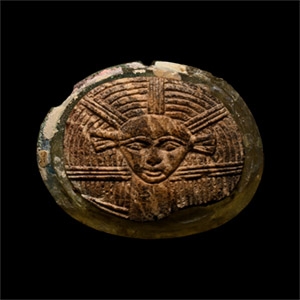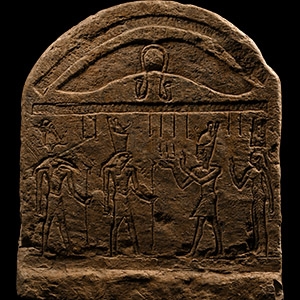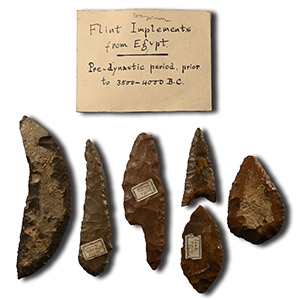Home > Auctions > 4 - 9 March 2025
Ancient Art, Antiquities, Books, Natural History & Coins
Ex Reine Margot, 1973.
Ex R. Liechti (1934-2010) Geneva, Switzerland, collection between 1950-1990s.
This lot is accompanied by an illustrated lot declaration signed by the Head of the Antiquities Department, Dr Raffaele D’Amato.
Cf. Andrews, C., Amulets of Ancient Egypt, London, 1994, p.25, fig.21f, for similar.
In the judgment of the dead (Book of the Dead, saying 125), Thoth, who is often represented in ibis form, records the result of weighing the heart of the deceased. The god is therefore mostly depicted in connection with the goddess Maat, whose feather was used as a counterbalance to the purity of the heart; such amulets were thus aimed at protecting the deceased from failing in the decision of the court of the dead.
Mr F.D. collection, acquired on the European art market, 1975 to present.
This lot is accompanied by an illustrated lot declaration signed by the Head of the Antiquities Department, Dr Raffaele D’Amato.
Cf. Andrews, C., Amulets of Ancient Egypt, London, 1994, p. 41, fig. 38, for examples of amulets of gods in precious metals.
Acquired between 1965-2020.
Private collection, London.
This lot has been checked against the Interpol Database of stolen works of art and is accompanied by search certificate no.12484-229828.
This lot has been cleared against the Art Loss Register database, and is accompanied by an illustrated lot declaration signed by the Head of the Antiquities Department, Dr Raffaele D’Amato.
Cf. Chadour, A.B., Rings. The Alice and Louis Koch Collection, volume I, Leeds, 1994, items 16 & 24, for type.
Images of Hathor with a human face and cow ears combine her human and bovine aspects. She is shown with a serene human face, symbolising her nurturing nature, while the cow ears emphasise her roles in fertility and motherhood. Hathor was one of the most important deities in ancient Egypt, revered as the goddess of love, beauty, music, dance, fertility, and motherhood. She was also associated with joy, childbirth, and women’s health. Hathor was believed to protect and nurture, often depicted as a maternal figure. As such, she was closely linked with Isis. She was closely linked to the sun god Ra, acting as a cosmic force facilitating life. In funerary contexts, Hathor was also seen as a guide for the dead, helping them transition to the afterlife. Her multifaceted role made her one of Egypt's most widely worshipped goddesses.
From a London and Home Counties collection, 1920-1940.
This lot is accompanied by an illustrated lot declaration signed by the Head of the Antiquities Department, Dr Raffaele D’Amato.
Cf. Ben-Tor, D., The Scarab: A Reflection of Ancient Egypt, Tel Aviv, 1993, pp. 76-77, nos. 1-15, for examples of this type of scarab.
Naturalistic scarabs carved in the round are characteristic of the Late Period and were crafted from various stones, including lapis lazuli, feldspar, carnelian, and rock crystal, as exemplified here. These scarabs were attached to the wrappings of a mummy, positioned over areas of the body such as the chest, neck, and hands.
Eric Pascoe (d. 2019), Calenick House, Truro, Cornwall.
Lodge & Thomas, Truro, Antiques & Fine Art Two Day Auction-Including the Ron Clifford Collection of Dinky & Britain's Toys, 26-27 September 2019, no.684.
Acquired by the present owner at the above sale.
with Bonhams, London, 8 December 2022, no.265.
This lot is accompanied by an illustrated lot declaration signed by the Head of the Antiquities Department, Dr Raffaele D’Amato.
This fragment from an elaborate pectoral may exemplify an innovative design characteristic of the Ramesside Period, during which iconographic and textual elements began to diverge from the more conventional styles of earlier pectorals. For a discussion of some of these novel pectorals, refer to Whelan, P., 'An Epithet-Laden Pectoral,' Egitto e Vicino Oriente, 46 (2023), pp.7-28.
Acquired in the mid-1980s-1990s.
Private collection, Switzerland, thence by descent.
Private collection, since the late 1990s.
Accompanied by an academic report by Egyptologist Paul Whelan.
This lot has been checked against the Interpol Database of stolen works of art and is accompanied by search certificate number no.12200-222172.
This lot has been cleared against the Art Loss Register database, and is accompanied by an illustrated lot declaration signed by the Head of the Antiquities Department, Dr Raffaele D’Amato.
Cf. Bosticco, S., Museo archaeologico di Firenze: le stele egiziane di epoca tarda Rome, 1972, no. 58, for an arch-topped stela depicting the pharaoh offering the 'field' symbol to the gods Her-wer and Sobek.
The overall tripartite composition is comparable to numerous stelae of the Ptolemaic Period and can be dated to the 3rd-2nd century B.C. The decorative lunette and/or sky bands and bold sunk relief winged sun disc are characteristic of this period, as is the fringed detailing of the female’s garment. The offering of the ‘field’ symbol is also a frequent depiction of the stelae of this period, which can be understood as a ‘catch-all’ device representing an offering of all the produce from the fields. Such stelae were often produced as stock products to which clients would have their names and other details added. Therefore, the stela is likely an example of one awaiting purchase. After the purchase, the hieroglyphic labels would be added to the figurative tableau, and a dedicatory text would be carved into the plain rectangle in the lower part. Sometimes, however, it appears that a purchaser could not afford the additional expense of a professionally engraved inscription, and so would scratch a short dedication in the lower panel as seen, for example, in the stela for Horudja from the Delta site of Tanis and now in the Musée du Louvre (inv. no. AF 11682).
Private collection, Europe.
with Sotheby's, London, July 1991, no.162.
Acquired by the current owner from the above.
Accompanied by a copy of the relevant Sotheby's catalogue pages.
This lot has been checked against the Interpol Database of stolen works of art and is accompanied by a search certificate number no.12585-232180.
This lot has been cleared against the Art Loss Register database, and is accompanied by an illustrated lot declaration signed by the Head of the Antiquities Department, Dr Raffaele D’Amato.
Cf. a scene of fish preparation from the tomb of Montuemhat in the Fine Arts Museums of San Francisco (accession no. 51.4.2), with similar depictions of the fish.
The crisp and detailed carving and colour palette are reminiscent of reliefs from the grand Theban tomb of Montuemhat, Mayor and Fourth Priest of Amun (circa 700-650 B.C.).
From the private collection of Sydney Horne, 1920s-1940s.
This lot is accompanied by an illustrated lot declaration signed by the Head of the Antiquities Department, Dr Raffaele D’Amato.
Cf. Aufrère, S., Collections des Musées départementaux de Seine-Maritime, Rouen, 1987, pp.188-190, for comparable examples.
From a French estate, acquired between 1960 and 1980.
with SAS Cornette de Saint Cyr Auction, Paris, Vente 882, Mobilier et Objets d'art, 2 December 2014, lot 69.
Accompanied by a copy of a French cultural passport no.167062.
Accompanied by an academic report by Dr Alberto Maria Pollastrini.
This lot has been checked against the Interpol Database of stolen works of art and is accompanied by search certificate no.11807-206837.
This lot has been cleared against the Art Loss Register database, and is accompanied by an illustrated lot declaration signed by the Head of the Antiquities Department, Dr Raffaele D’Amato.
From an early 20th century Home Counties collection.
This lot has been checked against the Interpol Database of stolen works of art and is accompanied by search certificate no.11597-199209.
This lot has been cleared against the Art Loss Register database, and is accompanied by an illustrated lot declaration signed by the Head of the Antiquities Department, Dr Raffaele D’Amato.
Cf. Barker, G., Preparing for Eternity: Funerary models and wall scenes from the Egyptian Old and Middle Kingdoms, Oxford, 2022, p.113 figure 4.2, for a near-identical calving cow figure, possibly from Meir (now in the Royal Ontario Museum, Toronto, inv. no. 910.18.16.1-3); cf. The Metropolitan Museum, New York, accession numbers 2021.41.170 and 11.150.5, for similar human and animal figures of this date.
Such models would have been deposited in tombs; the purpose of such a scene was probably to evoke the season of spring, when calves were born, and the floodplain where farmers lived and raised their livestock.
Acquired by the family from an antiquities dealer in Egypt, October 1982.
Ex Dunkirk Manor, Theescombe, Stroud.
Mr F.D. collection, acquired from the above.
Accompanied by an academic report by Egyptologist Paul Whelan.
This lot has been checked against the Interpol Database of stolen works of art and is accompanied by a search certificate number no.12513-231999.
This lot has been cleared against the Art Loss Register database, and is accompanied by an illustrated lot declaration signed by the Head of the Antiquities Department, Dr Raffaele D’Amato.
Cf. similar head in the Brooklyn Museum under accession no.58.94, lacking the bronze fittings; another in the Metropolitan Museum of Art under accession no. 1972.118.195, in dense stone (greywacke) and lacking the lateral feather ornaments; cf. Bonhams, 25 April 2012, no.121, for similar.
This head likely originates from a large-scale standing figure of the underworld god Osiris. In contrast to the ubiquitous small bronze Osiris figurines found at cult sites throughout Egypt – which were left by pilgrims as votive offerings – large-scale wooden statues are much rarer. Their scarcity is partly due to the fragile nature of wood, which made such statues more susceptible to decay over time, but also because these larger figures were used in more specialised and exclusive ritual contexts. This is evidenced by the significant discovery of a large wooden Osiris statue in a cache of votive objects at Saqqara, associated with a temple shrine. The find suggests that the sizeable image of Osiris played an important role in religious ceremonies in the temple, where it presumably served as the focus of veneration. The Saqqara cache dates no later than the reign of Nectanebo II (360-343 B.C.), whose temple pavement covered it. However, the exact dating of the wooden statue is less certain, with estimates ranging from the New Kingdom to the 26th Dynasty.
Private collection, Germany, 1975.
European collection, 1980s-late 1990s.
By descent from the above to the present owner.
Accompanied by an academic report by Egyptologist Paul Whelan.
This lot has been checked against the Interpol Database of stolen works of art and is accompanied by search certificate number no.12201-218142.
This lot has been cleared against the Art Loss Register database, and is accompanied by an illustrated lot declaration signed by the Head of the Antiquities Department, Dr Raffaele D’Amato.
Cf. Stanwick, P., Portraits of the Ptolemies: Greek Kings as Egyptian Pharaohs, Austin, 2002, pp. 67, 103 Cat. A27, for similar.
The presence of tool marks around the neck and sides of the head, contrasting the smooth surface of the face and front part of the headdress, suggests that the sculpture is an unfinished piece. The noticeably heavy brow line is a feature of the 30th Dynasty style, which then influenced Ptolemaic royal portraiture (cf. Tomoum, N., The Sculptors' Models of the Late and Ptolemaic Periods, Cairo, 2006, pl.17, for a finished portrait assigned to the 30th Dynasty).
1 - 12 of 3546 LOTS

.jpg)
.jpg)


.jpg)

.jpg)

.jpg)
.jpg)
.jpg)
.jpg)



